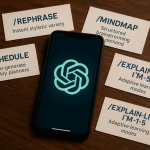Artificial Intelligence has transitioned from research labs to everyday life at astonishing speed. Voice assistants, AI-generated art, and automated customer service are only the earliest ripples of a much larger wave. Over the next five years, breakthroughs in model architecture, edge computing, and multi-agent coordination will push AI from helpful tool to ubiquitous co-worker—quietly enhancing nearly every decision we make. Understanding these fast-approaching capabilities is the first step toward thriving in an AI-saturated world.
Hyper-Personalized Digital Twins
By 2030, each of us may interact daily with an AI “digital twin”—a model fine-tuned on our preferences, communication style, calendar history, and biometric data. This assistant will not merely remind you of meetings; it will pre-draft emails, negotiate delivery times with other bots, and suggest health interventions before symptoms appear. Thanks to federated learning and on-device inference, these twins will operate locally for privacy yet continuously sync high-level insights to the cloud for collective intelligence.
Multimodal Mastery
Current large language models (LLMs) are absorbing vision and audio, but the next stage is true multimodal fluency: a single model interpreting CT scans, financial statements, and legal contracts in one prompt. Imagine uploading a three-hour board-meeting video and receiving an action-item matrix, risk analysis, and slide deck—all generated in minutes. Such capabilities will compress weeks of cross-disciplinary work into hours, forcing organizations to rethink project timelines and staffing models.
Autonomous Micro-Agents in the Workforce
The gig economy of the future may revolve around AI micro-agents bidding for tasks on decentralized marketplaces. One agent might draft social-media copy, another polishes the tone, a third schedules optimal posting times based on real-time sentiment analysis. Human workers will supervise swarms of these agents, focusing on high-order strategy and ethics while delegating granular execution.
Edge AI and Ambient Computing
With specialized chips like Apple’s Neural Engine and Google’s Tensor Processing Units shrinking in size and cost, AI inference will migrate from central servers to edge devices. Smart glasses will translate street signs on the fly; home sensors will detect early water leaks and cut the valve automatically; delivery drones will coordinate traffic corridors without relying on distant data centers. Latency will drop from hundreds of milliseconds to single digits, enabling real-time, privacy-preserving intelligence in every object we touch.
Regenerative Healthcare
AI-driven protein folding, generative molecular design, and digital pathology are converging to slash drug-discovery timelines and personalize treatment. Five years from now, AI could design bespoke gene therapies for rare diseases in under a month and predict population-scale disease outbreaks weeks in advance. Hospitals will deploy “clinical command centers” where AI triages incoming cases, allocates ICU beds, and optimizes surgical schedules, improving patient outcomes and staff well-being simultaneously.
Climate Intelligence Networks
Predictive models will fuse satellite imagery, IoT sensor data, and climate simulations to optimize everything from crop irrigation to city-wide energy usage. Municipalities will deploy AI to dynamically adjust traffic lights, public-transit frequency, and heating grids in response to real-time demand, saving megatons of CO2 annually. On the consumer side, AI-powered home batteries will trade surplus solar energy on micro-grids, turning households into active nodes of a renewable ecosystem.
Ethical and Governance Frontiers
As AI’s reach expands, so do questions of accountability, bias mitigation, and digital sovereignty. Expect new regulations mandating model transparency, audit trails, and “right to explanation” for automated decisions. Companies will need AI-ethics officers and robust validation pipelines akin to financial audits. Nations will jockey to set global standards, making governance knowledge as critical as technical prowess.
How to Prepare for the AI-Enhanced Future
1. Cultivate AI Fluency, Not Just Literacy
Basic awareness of AI concepts is no longer enough. Professionals must learn prompt engineering, data-ethics principles, and the limitations of probabilistic outputs. Free MOOCs, internal hackathons, and cross-functional AI guilds can accelerate organizational upskilling.
2. Strengthen Uniquely Human Skills
Creativity, strategic judgment, cross-cultural empathy, and ethical reasoning will differentiate human talent. Invest in design thinking workshops, negotiation labs, and interdisciplinary forums that hone these abilities.
3. Build Modular, AI-Ready Infrastructure
Organizations should decouple data silos, implement real-time analytics pipelines, and adopt API-driven architectures. Such foundations allow rapid integration of new AI services without wholesale system overhauls.
4. Adopt Continuous Learning Loops
AI models degrade as reality shifts. Implement feedback loops—user ratings, anomaly detection, periodic retraining—to keep models relevant. Individuals can mirror this by scheduling quarterly skills audits and updating personal learning roadmaps.
5. Engage in Policy and Ethics Discussions
Whether through industry consortia or community town halls, participate in shaping AI governance. Understanding emerging regulations now will prevent costly compliance shocks later.
Conclusion
The next five years will see AI evolve from task-specific assistant to ambient collaborator embedded in every tool, device, and decision process. Those who proactively cultivate technical fluency, human-centric skills, and ethical foresight will not merely adapt—they will lead. The future of AI is arriving at the speed of software updates; the time to prepare is today.



gonna change everything, get ready now!😲